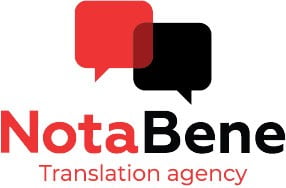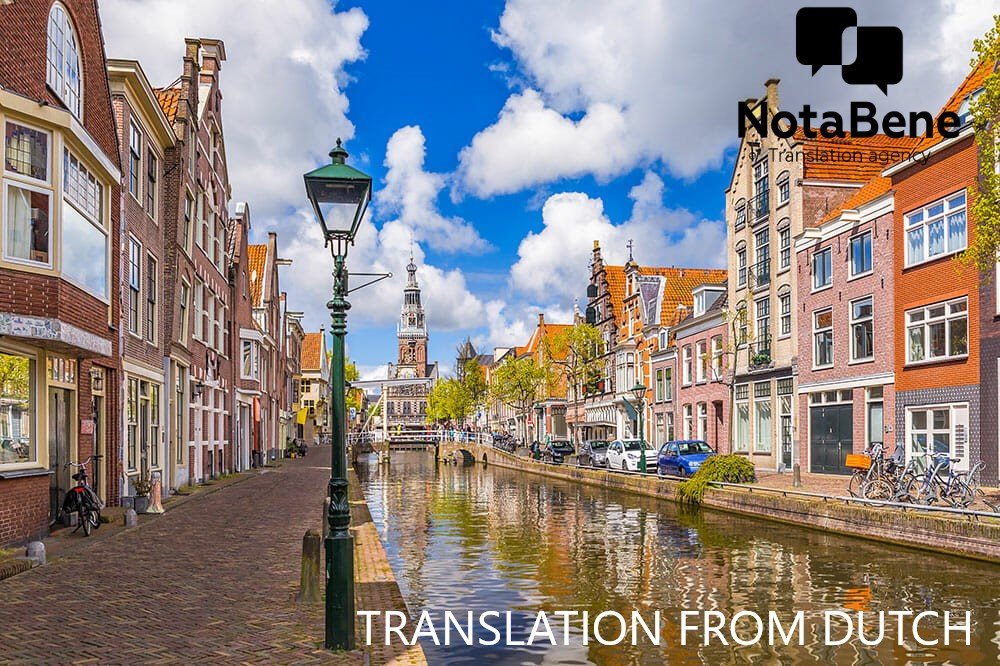Order translation from Dutch or into Dutch at Nota Bene Agency in Warsaw and Gdansk!
NotaBene Translation Agency is an experienced supplier of translation from Dutch into Polish and vice versa for any documents or texts.
What types of texts does NotaBene Translation Agency work with?
– Technical translation from Dutch — we translate any texts in electronics, aviation and shipbuilding, agriculture, industry, oil and chemistry, etc. For this purpose, we pick translators who understand the specific nature of a given industry.
– IT translation from Dutch for the localization of applications, games, software and websites.
– Medical translation from Dutch — books, manuals, articles in specialized printed and online publications, clinical records, correspondence with medical institutions, transcriptions and translations of test results, instructions for medicines and many other types of texts. This kind of translation requires flawless knowledge of medical terminology and focus on detail to rule out ambiguity, because the result can affect the health or life of many people.
– Legal translation from Dutch: statutes, registration deeds, articles of incorporation, contracts, powers of attorney, court records and many other similar documents.
– Financial translation from Dutch: this type of translation includes the translation of balance sheets, tax returns, payment invoices, waybills, tender documents, etc.
– Literary or fiction translation is the translation from Dutch of fiction, marketing and advertising materials. Unlike the previous types of translation, in this case there is more room for a translator’s creativity, because there is no need for “word for word” translation. The most important thing is that the translated material produces the same impact as the original, while an excellent translation may even make it better.
Please note that the translation mentioned is certified by an agency seal only. If you need sworn translation, kindly notify your manager in advance. Sworn translation is possible only for certain languages.
How to have a translation from Dutch into English, Polish, Russian, Belarusian or Ukrainian and vice versa?
First of all, you need to order it. To do so, send your source text and specify your requirements for the translation from Dutch. A customer service specialist at the Nota Bene Translation Agency will prepare a ToR based on the specific features of the order. If the project involves more than one job, a unique glossary is created to ensure the consistency and proper use of terminology.
An entire team of several professionals normally works on a job: a translator, proofreader, editor, quality controller, layout designer and manager who will be available during working hours. In order to rule out human errors, the translation agency uses modern services to check punctuation, idioms, numerical expressions, and formulas. The material is also reviewed by the chief editor.
Confidentiality of translated data is ensured by a special NDA, whenever a customer wishes to have one. Documents can be delivered to any country.
We very rarely apply additional fees for “urgency” or “specialized subjects”, so you can be sure that the price will not rise when the project is delivered. It is true that in rare cases, such as “we need to have it yesterday” instances, and when a customer is willing to pay a higher rate for the team to work outside normal working hours, at night or on weekends, the fee might be increased, but this is always negotiated with the customer in advance.
Exciting facts about the Dutch language
1. Dutch is spoken by 23 million people. This makes it the 8th most common European language and one of the top 40 most spoken languages in the world. Approximately 17 million Dutch speakers live in the Netherlands. The rest live in other European countries as well as Suriname, the Antilles and Aruba. Communities of Dutch speakers can be found in the US, Canada, Australia, New Zealand and elsewhere.
2. The structure of the Dutch language is well described by the joke, – “The Dutch language appeared when a drunken German tried to speak English”. Indeed, there are many words reminiscent of English and German. Even the grammar is taken from these languages. At the same time there are some distinctive features. For example, double vowels are very common in Dutch: gemeente, vaal, gaan, doorn.
3. In its time, the Dutch language had an opportunity to be as international as French was in the 18th and 19th century and English is today. In the seventeenth century, the colonies of the small Netherlands covered a huge area. Plus the country was trading with literally the whole world. There are still people in Indonesia who use Dutch as their everyday language.
4. As a result of this spreading, Dutch has become a basis for many languages. The Afrikaans spoken today in South Africa and Namibia (around 10 million speakers) is a direct descendant of Dutch, and was even considered to be a dialect until 1925. Also Asian countries for some time used creole languages, which were based on the Dutch language. Most of them are now extinct.
5. Dutch started to form around the 5th century AD. The oldest text found so far, written in one of the old dialects of this language, dates back to 1100. For a modern speaker it is quite impossible to read. The first literary works in Dutch began to appear in the 13th century. Around the same time, the language began to supplant French and Latin in the areas where the modern Netherlands is located. Teaching in Dutch began in 1797 at Leiden University.
6. There is no “Y” in the modern Dutch alphabet. It is substituted by the digraph “ij”, which is read as something in between “ay” and “yaj”. As for the letter “y”, it is found only in loanwords and in obsolete variants of writing. Also, in some cases the “ij” is changed to “y” intentionally to make it easier for foreigners to read. A classic example is the name of the car company Spyker, which was founded by Dutch entrepreneurs with the surname Spijker.
7. Many learners of Dutch wonder about the abundance of diminutives in everyday speech (and not only in Dutch). There is a theory, according to which it is done in order to simplify the speech. The thing is that in Dutch there are two articles – “het” and “de”, the rules for using them are rather vague and confusing. In the case of diminutives, there is always one article – “het”. Naturally, for a literary or business language, such an approach is not suitable.
8. There are many borrowings from the Dutch language. Typical examples: stoel – chair; broek – trousers (diphthong “oe” reads as “u”); oester – oyster. A lot of words also come from nautical themes: yacht, clipper, admiral, sailor, raid, hold and many others. Most of these borrowings came into the Russian language during the time of Peter the Great.
We have been in business for over 20 years and during that time we have learned to work well. Trust us with your translation from Dutch and get a great result at a reasonable price!








